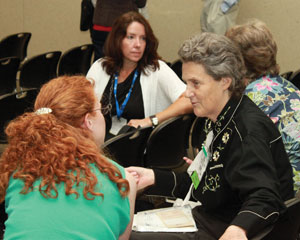Euthanasia experts say best methods may be unappealing
Temple Grandin, PhD, understands that many people may think physical methods of euthanasia are "icky," but contends that often they are the best methods for providing animals a humane death.
Speaking during a lecture in July at the AVMA Annual Convention in St. Louis, she noted that the handling associated with "nonphysical" euthanasia methods, such as barbiturate overdose, can cause stress, particularly among wild animals, as evidenced by higher cortisol concentrations than in animals accustomed to human contact.
During her talk, Dr. Grandin provided information on the proper application and use of physical euthanasia methods—including the use of guns, captive bolt devices, and electricity. Her presentation was part of a daylong series of lectures on euthanasia by various speakers.

Dr. Jan K. Shearer, who described the acceptable methods for poultry, cattle, small ruminants, and pigs, also indicated physical methods are often a humane alternative to the stress of human contact.
"The stress of restraining the animal is often much greater than people realize," Dr. Shearer said.
Dr. Steven L. Leary, chair of the AVMA Panel on Euthanasia, said the panel has been working to update the AVMA Guidelines on Euthanasia at a time of increased public attention to humane treatment, of which euthanasia is an important part. That public interest is reflected in laws, policies, and regulations, and the AVMA is expected to provide leadership.
Earlier this year, the Panel on Euthanasia published at www.avma.org the draft updates for the AVMA Guidelines on Euthanasia, and the AVMA said it would accept comments on the guidelines through Sept. 1. Dr. Leary noted that the final document will become the eighth edition of the guidelines, which were first published in 1963.
"This is a living document that will continually improve," Dr. Leary said.
Raymond Anthony, PhD, who served as an ethicist on the Panel on Euthanasia, said a trend in the field of animal ethics has been to consider animals not as equals or solely as resources but as beings that deserve some moral consideration. He said such consideration involves providng suitable husbandry and an acceptable environment, rather than merely preventing cruelty.
In considering the ethics of euthanasia, Dr. Anthony said animal welfare competes with technologic capability, economics, laws, and client interests. He said veterinarians may also have varied influences, such as differing information and philosophies, and the profession needs to respond to such dilemmas.
In listing considerations for what euthanasia technique would be appropriate for an animal, Dr. Anthony indicated considerations include what is best for veterinarians' clients, veterinarians' consciences, public perception, laws, and balance of harms to animals and people.
In discussing appropriate uses of inhalational methods of euthanasia, Dr. Robert E. Meyer noted that the suitability of a euthanasia agent depends on whether it causes distress or pain prior to loss of consciousness.
"As a general rule of thumb, a gentle death that takes longer is preferable to a rapid, distressing death," Dr. Meyer said.
The draft AVMA Guidelines on Euthanasia are available at https://www.avma.org/KB/Policies/Pages/Euthanasia-Guidelines.aspx